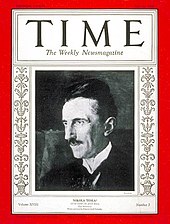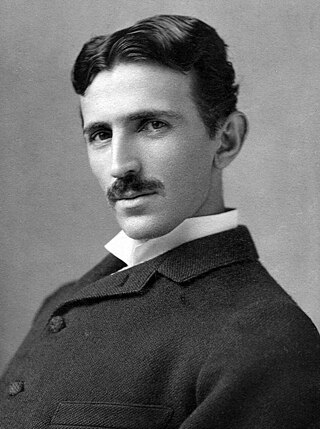
Nikola Tesla was a Serbian-American inventor, electrical engineer, mechanical engineer, and futurist best known for his contributions to the design of the modern alternating current (AC) electricity supply system.
The early history of radio is the history of technology that produces and uses radio instruments that use radio waves. Within the timeline of radio, many people contributed theory and inventions in what became radio. Radio development began as "wireless telegraphy". Later radio history increasingly involves matters of broadcasting.

Joseph Henry was an American scientist who served as the first Secretary of the Smithsonian Institution. He was the secretary for the National Institute for the Promotion of Science, a precursor of the Smithsonian Institution. He was highly regarded during his lifetime. While building electromagnets, Henry discovered the electromagnetic phenomenon of self-inductance. He also discovered mutual inductance independently of Michael Faraday, though Faraday was the first to make the discovery and publish his results. Henry developed the electromagnet into a practical device. He invented a precursor to the electric doorbell and electric relay (1835). His work on the electromagnetic relay was the basis of the practical electrical telegraph, invented separately by Samuel F. B. Morse and Sir Charles Wheatstone. In his honor, the SI unit of inductance is named the henry.
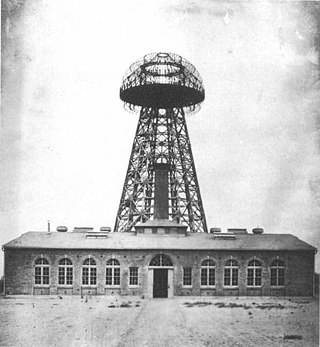
Wardenclyffe Tower (1901–1917), also known as the Tesla Tower, was an early experimental wireless transmission station designed and built by Nikola Tesla on Long Island in 1901–1902, located in the village of Shoreham, New York. Tesla intended to transmit messages, telephony, and even facsimile images across the Atlantic to England and to ships at sea based on his theories of using the Earth to conduct the signals. His decision to increase the scale of the facility and implement his ideas of wireless power transmission to better compete with Guglielmo Marconi's radio-based telegraph system was met with refusal to fund the changes by the project's primary backer, financier J. P. Morgan. Additional investment could not be found, and the project was abandoned in 1906, never to become operational.

The Tesla Experimental Station was a laboratory in Colorado Springs, Colorado, USA built in 1899 by inventor Nikola Tesla and for his study of the use of high-voltage, high-frequency electricity in wireless power transmission. Tesla used it for only one year, until 1900, and it was torn down in 1904 to pay his outstanding debts.

Peter Schuyler Miller was an American science fiction writer and critic.
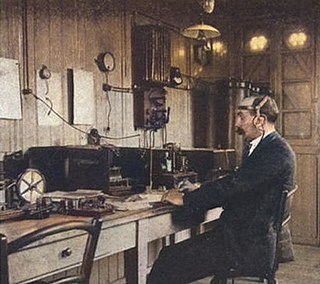
The invention of radio communication was preceded by many decades of establishing theoretical underpinnings, discovery and experimental investigation of radio waves, and engineering and technical developments related to their transmission and detection. These developments allowed Guglielmo Marconi to turn radio waves into a wireless communication system.
Visual reasoning is the process of manipulating one's mental image of an object in order to reach a certain conclusion – for example, mentally constructing a piece of machinery to experiment with different mechanisms. In a frequently cited paper in the journal Science and a later book, Eugene S. Ferguson, a mechanical engineer and historian of technology, claims that visual reasoning is a widely used tool used in creating technological artefacts. There is ample evidence that visual methods, particularly drawing, play a central role in creating artefacts. Ferguson's visual reasoning also has parallels in philosopher David Gooding's argument that experimental scientists work with a combination of action, instruments, objects and procedures as well as words. That is, with a significant non-verbal component.

Nikola Tesla is portrayed in many forms of popular culture. The Serbian-American engineer has particularly been depicted in science fiction, a genre which is well suited to address his inventions; while often exaggerated, the fictionalized variants build mostly upon his own alleged claims or ideas. A popular, growing fixation among science fiction, comic book, and speculative history storytellers is to portray Tesla as a member of a secret society, along with other luminaries of science. The impacts of the technologies invented by Nikola Tesla are a recurring theme in the steampunk genre of alternate technology science-fiction.
Thomas Edison has appeared in popular culture as a character in novels, films, comics and video games. His prolific inventing helped make him an icon and he has made appearances in popular culture during his lifetime down to the present day. He is often portrayed in popular culture as an adversary of Nikola Tesla.
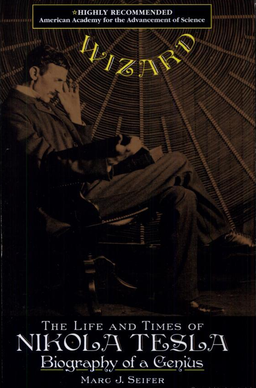
The book Wizard, the Life and Times of Nikola Tesla is a biography of Nikola Tesla by Marc J. Seifer published in 1996.

The Inventions, Researches and Writings of Nikola Tesla is a book compiled and edited by Thomas Commerford Martin detailing the work of Nikola Tesla through 1893. The book is a comprehensive compilation of Tesla's early work with many illustrations.

Colorado Springs Notes, 1899–1900 (ISBN 8617073527) is a book compiled and edited by Aleksandar Marinčić and Vojin Popović detailing the work of Nikola Tesla at his experimental station in Colorado Springs at the turn of the 20th century.
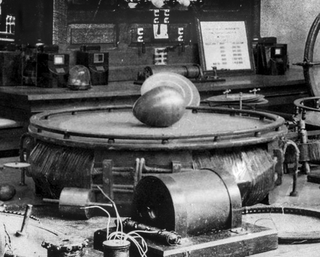
Tesla's Egg of Columbus was a device exhibited in the Westinghouse Electric display at the 1893 Chicago World's Columbian Exposition to explain the rotating magnetic field that drove the new alternating current induction motors designed by inventor Nikola Tesla by using that magnetic field to spin a copper egg on end.
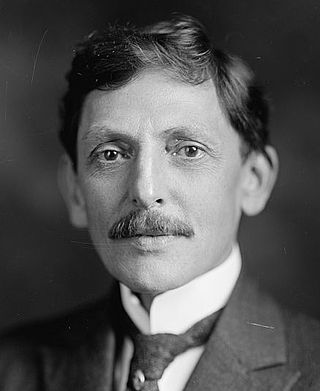
Paul Bartsch was an American malacologist and carcinologist. He was named the last of those belonging to the "Descriptive Age of Malacology".

The World Wireless System was a turn of the 20th century proposed telecommunications and electrical power delivery system designed by inventor Nikola Tesla based on his theories of using Earth and its atmosphere as electrical conductors. He claimed this system would allow for "the transmission of electric energy without wires" on a global scale as well as point-to-point wireless telecommunications and broadcasting. He made public statements citing two related methods to accomplish this from the mid-1890s on. By the end of 1900 he had convinced banker J. P. Morgan to finance construction of a wireless station based on his ideas intended to transmit messages across the Atlantic to England and to ships at sea. His decision to change the design to include wireless power transmission to better compete with Guglielmo Marconi's new radio based telegraph system was met with Morgan's refusal to fund the changes. The project was abandoned in 1906, never to become operational.

John George Trump was an American electrical engineer, inventor, and physicist. A professor at the Massachusetts Institute of Technology from 1936 to 1973, he was a recipient of the National Medal of Science and a member of the National Academy of Engineering. Trump was noted for developing rotational radiation therapy. Together with Robert J. Van de Graaff, he developed one of the first million-volt X-ray generators.

The Tesla Science Center at Wardenclyffe is a nonprofit organization established to develop a regional science and technology center, museum and makerspace at the site of Nikola Tesla's former Wardenclyffe laboratory on Long Island, New York. The center had raised money through crowdfunding to purchase the property. In 2018, the Wardenclyffe site was listed on the National Register of Historic Places.

Nikola Tesla patented the Tesla coil circuit on April 25, 1891. and first publicly demonstrated it May 20, 1891 in his lecture "Experiments with Alternate Currents of Very High Frequency and Their Application to Methods of Artificial Illumination" before the American Institute of Electrical Engineers at Columbia College, New York. Although Tesla patented many similar circuits during this period, this was the first that contained all the elements of the Tesla coil: high voltage primary transformer, capacitor, spark gap, and air core "oscillation transformer".
